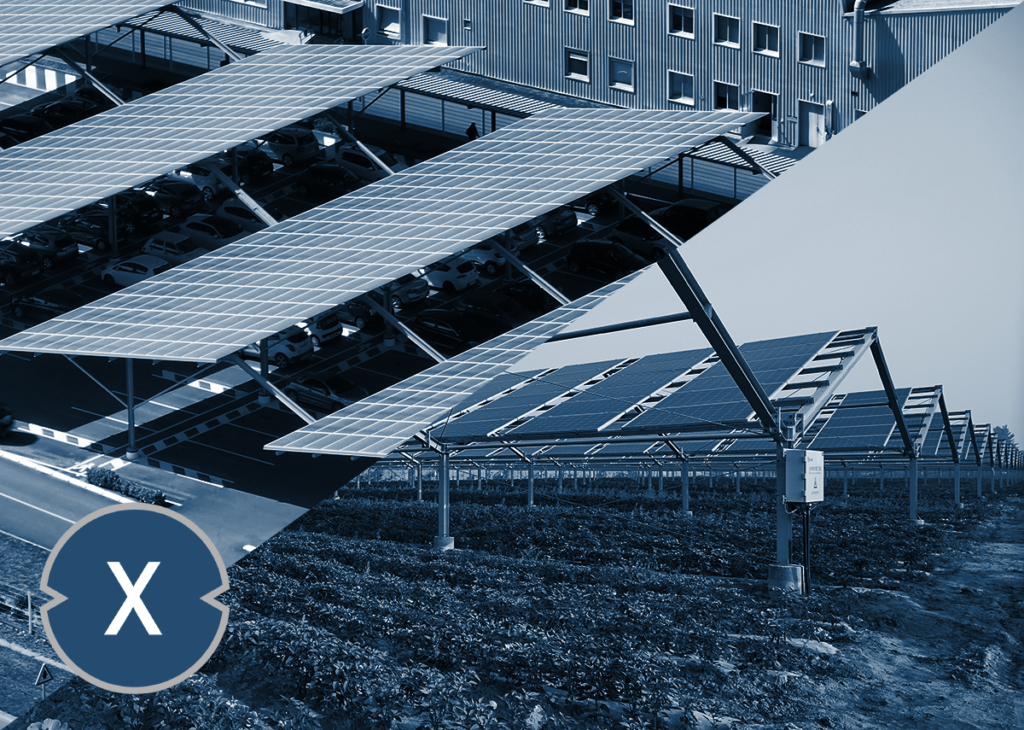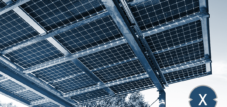The semi-transparent double glass modules create an overall aesthetic appearance of the photovoltaic or solar system: They make a modern statement for self-sufficient power generation! Due to their nature, the solar modules are extremely robust and durable. They combine aesthetics with a high electricity yield.
Extremely light and yet very stable
The sun shining through the double glass modules brings a lot of light to the areas to be covered. By using specially hardened glass with a thickness of only 2 mm (front and back glass), the frameless solar module weighs only 20 kg and is therefore lighter than the few competing models, which often weigh 30 kg with the same performance.
Aesthetics in BiPV applications is also recognized by architects
Private or public roofs, for example on terraces and carports, are enhanced energetically and visually. The aesthetics of the bright lounge areas under the transparent modules are convincing and prevent the skepticism that architects and developers often have towards building-integrated PV systems.
Test successfully passed according to the European standard EN 12600. Safety against falling splinters in the event of a breakthrough.
This protection against injuries caused by glass breakage is provided by the double-glass solar modules we recommend.
The effective protection against violent breakthrough is based on a combination of glass and the laminate as a tough-elastic intermediate layer. The European standard EN 12600 (glass in construction – pendulum impact test) is used to test such glass-glass laminates. This is a method for impact testing and classification of flat glass. This standard also applies analogously to laminated double glass modules.
BiPV - Building-integrated Photovoltaic / GiPV - Building-integrated photovoltaic
Building-integrated photovoltaics means the integration of photovoltaic modules into the building shell, whereby not only classic energy generation (conversion of sunlight into electrical energy), but also other functions are desired. The specialist group “Photovoltaics in Buildings” under the umbrella of the Federal Association for Building Systems e. V. describes BiPV as an architectural, building physics and structural integration of PV elements into the building shell, taking into account the multifunctional properties of the PV module. Multifunctionality can include weather protection, thermal insulation, shading, aesthetics and design as well as privacy protection, sound insulation, electromagnetic shielding, burglary protection, light control and conduction.
BiPV is used in the area of roof integration, facade, window and shading solutions. Project-oriented variants (adapted to the respective building) in size, shape, material, color, variance in transparency and design are desired in order to achieve an overall appearance that is as homogeneous as possible.
In order to take architectural requirements and the desired multifunctionality into account, the PV modules need to be adaptable in terms of size, shape and materials used. The various mechanical and electrical integration requirements must also be taken into account.
Basically, there are two variants of technologies that can be used for modules for BiPV:
- Crystalline modules Crystalline modules are constructed based on several silicon wafers, usually connected in series. The grid dimension of the variation in size is determined by the size of the wafers and the necessary clearances for interconnection and isolation. These amount to 15-25 cm. When it comes to cell material, a distinction is made between monocrystalline and polycrystalline silicon, which differ in their efficiency. This indicates what percentage of the incoming solar energy is converted into electrical energy. (Mono)crystalline modules today offer the highest efficiency (15–20%) with optimal alignment. In BiPV, however, such an optimal alignment (e.g. facade with vertical alignment) is usually not possible. Furthermore, crystalline solutions are very susceptible to shading and reduction in performance at high temperatures, which are common in building applications. It is therefore advisable to use simulation software to determine the true energy yield. Crystalline solutions have a high variability in the choice of packaging material, which is very positive for BiPV. Different glass thicknesses and also plastics can be used, but crystalline cells are very susceptible to breakage and cannot be bent. Semi-transparency in simple patterns can also be created.
- Thin-film modules Thin-film modules are applied to a substrate (usually glass). With the glass substrate variant, size variation is only possible to a very limited extent. The choice of material for this variant of the substrate is also very limited, as very high temperatures are used during the process of building the PV cell, which make certain variations in the glass (e.g. safety glass) not possible. Other thin-film solutions are used, for example. B. applied to plastic or metal strips (steel, copper). These solutions currently offer the highest degree of variation in size and packaging and make it possible to also offer flexible and very light solutions (plastic/plastic). Thin film solutions currently have efficiencies of 6-14% depending on the technology used, have better yields in suboptimal alignment (scattered light, low light) and are less temperature dependent in their performance.
Special funding
Various political measures promote the use of BiPV: Driven by the 20-20-20 goals and the desire to promote energy self-sufficient buildings, in some countries (e.g. Italy, France) in addition to the feed-in tariffs (see Germany EEG) increased tariffs for BiPV are offered.
In Switzerland, roof-integrated solar systems / photovoltaic systems are more highly subsidized than standard systems.
Building guidelines
A strong driver for the use of BiPV is the gradual tightening of guidelines regarding the energy behavior of buildings (zero energy house, CO2 footprint). In Germany, the EnEV is the reference here, which is based on the EU directive on the overall energy efficiency of buildings. There are also country-dependent sustainability-related building assessments with different quality levels, which also promote high energy building quality and low environmental impact. Examples of this include Leadership in Energy and Environmental Design (LEED) developed in the USA, BREEAM from Great Britain and the German Seal of Quality for Sustainable Building.
Three crucial properties
For solar modules: Samples of various solar cells of polycrystalline and monocrystalline types – Image: Xpert.Digital / Petair|Shutterstock.com
Suitable for:
The fulfillment of the building law requirements for overhead glazing were tested in accordance with the EN 12600 standard in an accredited institute with regard to the fulfillment of the following properties:
- Splinter retention: Even if the panes are destroyed, no sharp shards of glass should fall out
- Penetration resistance
- Residual load-bearing capacity: The overhead glazing must have a high level of resistance to loads and still have a minimum load-bearing capacity even if damaged.
The double-glass solar modules we recommend have passed all tests with flying colors. Not a single module was massively damaged or even punctured. The modules can therefore be used for overhead glazing, facade installations and as balcony modules. This results in a wide range of applications, ranging from terraces to carports, large parking lot roofing, industrial hall roofing and sports facility roofing.
What additional advantages do the double glass modules we recommend have?
Suitable for:
The glass-glass solar modules are durable and extremely robust against all weather influences. They are as light as conventional modules and are easy to assemble. The advantage of glass-glass modules is the material: glass does not age. It offers the best protection for solar cells and ensures that the modules will continue to be particularly efficient even decades into the future.
Price and performance speak for double-glass solar modules
If you compare glass-glass solar modules with glass-film modules, the costs must be considered over their entire service life. It is also important how much energy a module delivers during this time. With glass-glass modules, photovoltaic system operators get a high-performance product that lasts much longer than a glass-film module. This means that with almost the same price and a longer service life, the glass-glass solar module produces much more solar power.
📣 Open parking areas Photovoltaic solutions for industry, retail and municipalities
Everything from a single source, specially designed for solar solutions for large parking areas. You refinance or counterfinance into the future with your own electricity generation.
🎯 For solar engineers, plumbers, electricians and roofers
Advice and planning including a non-binding cost estimate. We bring you together with strong photovoltaic partners.
👨🏻 👩🏻 👴🏻 👵🏻 For private households
We are positioned across regions in German-speaking countries. We have reliable partners who advise you and implement your wishes.
- Plan photovoltaics for warehouses, commercial halls and industrial halls
- Industrial plant: Plan a photovoltaic open-air system or open-space system
- Plan solar systems with photovoltaic solutions for freight forwarding and contract logistics
- B2B solar systems and photovoltaic solutions & advice
For architects and solar system builders: Xpert.Solar for planning and consulting in the area of green solar carports, solar systems on roofs and photovoltaic systems in general. We also support you in finding the right and suitable solar modules!
I would be happy to serve as your personal advisor.
You can contact me by filling out the contact form below or simply call me on +49 89 89 674 804 .
I'm looking forward to our joint project.
Xpert.Digital – Konrad Wolfenstein
Xpert.Digital is a hub for industry with a focus on digitalization, mechanical engineering, logistics/intralogistics and photovoltaics.
With our 360° business development solution, we support well-known companies from new business to after sales.
Market intelligence, smarketing, marketing automation, content development, PR, mail campaigns, personalized social media and lead nurturing are part of our digital tools.
You can find out more at: www.xpert.digital – www.xpert.solar – www.xpert.plus


